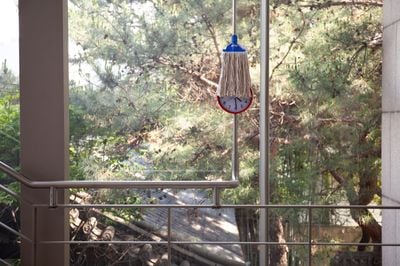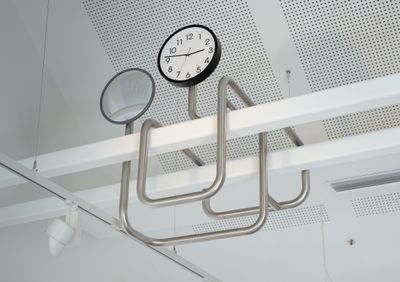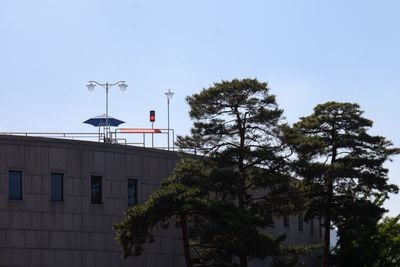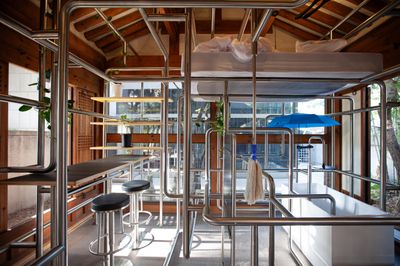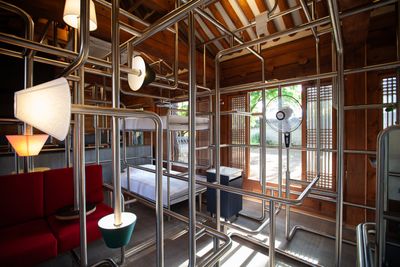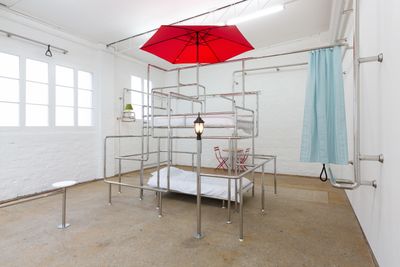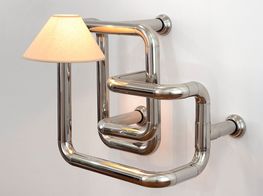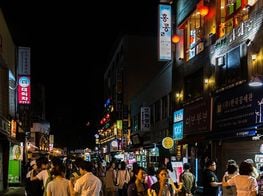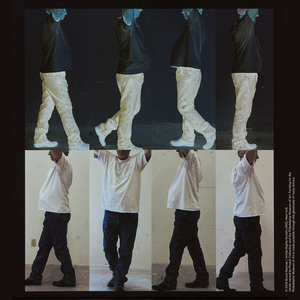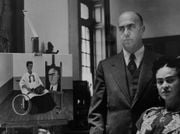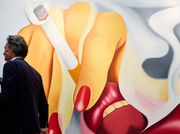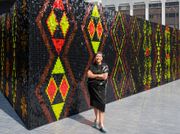Yona Lee Dismantles Hierachies of Space
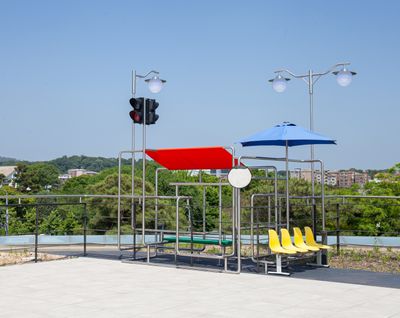
Exhibition view: Yona Lee, An Arrangement for a Room in Seoul, Art Sonje Center, Seoul (24 May–4 August 2024). Courtesy © Art Sonje Center. Photo: Seowon Nam.
At Art Sonje Center, Yona Lee's solo exhibition, An Arrangement for a Room in Seoul, extends far beyond any preconceived confines of a dwelling.
To the outsider, Seoul can be an overwhelming city, with its vast population and dense juxtaposition of centuries-old wooden structures and flashy modern architecture. This contrast can be seen on a micro level within the grounds of the institution Art Sonje Center in Jongno-gu, an area of downtown Seoul that was once the heart of the Joseon dynasty.
I meet Yona Lee outside Art Sonje on a beautiful, mild evening with clear blue skies and the sun still lingering. Given that the artist has just finished her third day of installing, she is surprisingly energetic and in good spirits. With the gallery currently closed to the public for the install, she ushers me through a door that has been opened just enough to allow us to squeeze through sideways. Inside, I immediately recognise the stainless-steel tubing—Yona's primary media—dispersed through the space and, above one end of the ground-floor stair rail, affixed to a thick, vertical steel pole, is an inverted mop head. As we pass it, Yona strokes its pristine, loose-hanging cotton strands with affection.
'It's going well,' she says of the installation. Only a few days prior she was in Melbourne for a group show at Buxton Contemporary, The same crowd never gathers twice, where her distinct stainless-steel rail works traverse the exhibition spaces, including on a ceiling beam, while another installation wraps around a tree outside the gallery.
Yona takes me through Art Sonje's foyer to the hanok, a traditional Korean house, which is set within the centre's enclosed courtyard and visible from inside through a glass wall. The structure is framed by thick, cylindrical, vertical wooden beams and a traditional roof, with rickety sets of doors that have crisscrossing slats laid over hanji paper (handmade from paper mulberry bark). Yona notes that these will all be opened up when her installation is complete, allowing people to go inside to navigate the steel maze within.
Surrounded by a high, grey-brick fence bordered with tall pine trees and bamboo, the fortress-like space of the courtyard feels worlds away from the bustling city streets on the other side. Close to the Gyeongbokgung Palace complex, Jongno-gu is a popular destination for tourists, with many walking about wearing rented hanbok—traditional Korean attire—and posing for photos against picturesque backdrops of paved alleys, greenery, brick walls, hanok, and hip cafes.
Yona tells me that she will be filling the currently empty hanok with a new iteration of her labyrinthine, steel-rail installation, An Arrangement for a Room in Seoul (2024). But rather than simply seeing the hanok as an extension of the exhibition space, she views it as a sculptural object in itself. 'On the rooftop,' she adds, 'the view of Seoul will become part of the work, too.'
She leads me up all three floors of the open, zig-zagging staircase. The space is still a construction site, with loose steel poles—some straight, others bent—languishing like dormant snakes at each landing, and various tools and components scattered about: a tape measure, loose screws, electrical wiring, a drill, a laser level. A tubular steel handrail runs continuously along the top of the gallery's existing flat one—an intervention that is recognisably by Yona.
The view from the rooftop, which is the culmination of the installation, is spectacular, with 360-degree views of the dramatic ridgelines and silhouettes of the surrounding mountains Bukhansan, Bugaksan, and Inwangsan, and the confluence of historic and modern architecture across the city. The terrace is a massive open space, but Yona's footprint here is decisively light: aside from one large steel structure cast to one corner—complete with street lamps, a pair of traffic lights, a bright blue umbrella, a red shade sail, and a green bench—and one continuous rail running the perimeter of the rooftop, it remains mostly empty.
As we begin our descent back down to ground level, Yona grabs a stray yellow plastic chair seat, securing it under one arm. With such complex, large-scale projects that are effectively minor feats of engineering, you would imagine the artist might have a team of fabricators, welders, spatial designers, engineers, electricians, and technicians. But for the most part, she develops and produces her installations by herself. Over the years she has become a skilled welder and metal-worker, and is adept at using software to make 3D drawings in the concept phase. 'I get a lot out of actually being involved in the making,' she tells me.
For the Art Sonje show, however, Yona has someone assisting her with the more intensive metal work—welding and polishing—while she has been doing the joining. Although her early installations such as In Transit (Arrival) (2017) were predominantly welded together, she now mainly joins her structures using a bolting system she developed while building her mammoth installation An Arrangement for 5 Rooms, at Auckland Art Gallery Toi o Tāmaki in 2022.
Back in the courtyard, Yona pulls out her Macbook from her backpack and opens up Blender, the program she uses to develop 3D renders of her installations. On the screen is a render of the hanok space, filled with a cage of tubular railing and the familiar utilitarian objects that populate her works—lamps, mattresses, a table, chairs, and an umbrella among them.
These juxtapositions of old and new are particularly pertinent to Yona's hanok intervention. 'There's such an interesting, uncanny dialogue between the old stone and wood, which I saw a lot of potential in, and the new, modern materials.'
Within the hanok, Yona's installation will be suspended from the ceiling beams. 'I was really interested in the differences between Western and Korean building types,' she says. 'One main distinction is that European buildings are based on walls, or 벽, while the hanok is about 기둥, or the beam structures.'
'Understanding this transition from the hanok up the staircase to the rooftop—which creates a dramatic impact—required a greater understanding of the structures than the show at Auckland Art Gallery, which felt a little easier because of how the rooms were linear.'
Upon receiving the commission from Art Sonje, Yona recalls: 'The first thing I did was spend time here, in the hanok, and read the space—the flow, and what's unique about this context. There's the dialogue between the traditional house and the modern building, and this hierarchy between the ground-floor space and the rooftop.'
'Then I measured all the spaces with a laser and put them into SketchUp. It's interesting because the final work is so physical, but it all comes from virtual space,' she says, navigating her cursor through the render to give a sense of what it will look like to move through the finished piece.
'I let that understanding of the space come through, and then try to interpret it, through my work, to highlight things about it that I'm interested in.'
When I ask if she thinks that her perspective has evolved over the years—recalling her earlier large-scale installations, such as those presented at Te Tuhi in Auckland (2017), City Gallery Wellington (2018), and Lyon Biennale (2019)—she considers. 'It's definitely evolved. It's kind of strange because now I feel like the work has its own logic and a life of its own. It's really about systems, and following them.'
'Obviously I'm using the same materials—steel tubes and objects—but because space has become such an important part of the work, it's almost like the installations are doing their own thing now within different environments.'
'The idea of iteration is becoming more important to me and I always find myself referring back to the idea of performance.'
'One of my favourite violinists, Itzhak Perlman, talks about the difference between a jazz musician and a classical musician in relation to improvisation. A jazz musician would improvise—playing a different melody or rhythm—so that even the same piece of music sounds very different.'
'But in classical music, the idea of improvisation is more subtle. It's not about changing the melody or rhythm; it's about how you breathe, your tonal variation, your bow. If you don't pay close attention, you can't really tell the difference. The magic lies in how to keep it fresh when you perform the same piece of music. Even in repetition, creativity can come through.'
Likewise, by keeping certain constants in her practice, such as the tubular stainless-steel rails, Yona is able to stay carefully attuned to the sites she works within. 'The variations in the spaces, the context of the shows and the architecture become more important,' she notes. By mapping different spaces with her steel configurations, she sees this as a blurring of spatial categories and binaries that limit our understanding of reality.
'When I walk around a city I get so much inspiration seeing how things are made. What I like about this Samcheong-dong area is the blurring of past and present. It's definitely offering something else, having these two states fused together.'
Navigating the linguistic space of translation is also an inherent part of Yona's practice. The exhibition's Korean title, 공간 배치 서울, translates to Spatial Arrangement Seoul. Inhabiting the fluctuating gradations between two languages is an experience that, to an extent, we share. But, while I moved to Aotearoa at the age of three and have no memory of the experience, Yona was 12 when she emigrated, and she recalls how learning English was a battle. The tradeoff is that my Korean is sorely lacking, and I admire Yona's ease in communicating with the team at Art Sonje with a fluency and sensitivity to cultural codes and mannerisms that only a native speaker would possess.
But it's not as easy as Yona makes it seem. When she knows she needs to talk about her work in Korean, she'll revise ahead the vocabulary that is relevant to her practice, being less fluent with the vernacular of Korean art. Such terms include 장소 특정적 (site-specific), 사적 공간 (private space), 공적 공간 (public space), 밀도 (compression/density, or the ratio of people to space). 'Sometimes they don't come to me naturally,' she says.
Later, as we wander through the lanes of Jongno-gu on a quest to find somewhere to have dinner, we pass a restaurant with an integrated table and bench outside, its frame made of stainless-steel tubing in a satisfyingly curved, unified structure. Yona's face lights up; she pauses to take a picture of it on her phone, joking to me: 'You might see a similar design in my next work.' Her magnetic attunement to the material is infectious. On the train ride home, I see her in the steel poles, rails, and holding straps throughout the carriages. It's standing room only, and, weary from a long day of walking, I lean against one of the vertical poles, grateful for its cool touch. —[O]
